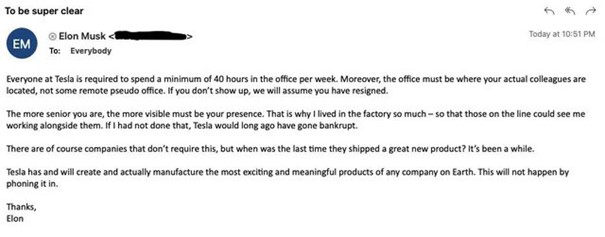
If you don’t show up, we will assume you have resigned. – Elon Musk
A few weeks ago Ian Goodfellow, the then Head of Machine Learning at Apple, made headlines by quitting over the company’s Return to Office (RTO) policy. This hybrid policy will have workers coming into the office three set days a week – a decision that has been criticised since Apple initially announced that there would be a gradual return to the office. While this hybrid model is meant to offer employees flexibility, due to its very specific nature it does the exact opposite.
The pandemic, and especially with the introduction of lockdowns, the number of people working from home skyrocketed. Since 2020, many employees have shifted into working from their homes and have in many cases found remote working more productive than doing so from an office. Remote work allows for greater flexibility in the structure of the working day, as well as how the work itself gets done. It has also relieved many people from lengthy commutes and the social conventions of working in an office.
Now, almost two years later remote work is still rampant, and has in some cases accelerated so far that people are employed for companies whose offices they have never even set foot in. There are cases were returning to the office would be detrimental to the employee or the quality of their work, or where a move to in-person work is simply impossible due to geographic distance.

Unfortunately, Apple is neither the first nor does it remain the only company to pull people back into the office. It seems many companies prefer to have their workers present in the office. The word “hybrid” is often thrown around in these cases, maybe in part to appease those who are firmly married to the idea of homeworking. The idea is to allow people a mixture of office and home working, to allow them more flexibility – however as seen in the case of Apple, hybrid does not necessarily mean flexible.
Another company that has very recently made waves over its RTO policy, is Tesla. Elon Musk, who is the Tesla CEO and currently richest man in the world, seems to have strong opinions about home vs office working too. In early June, an email Musk wrote to his staff was leaked on the internet. In the message he states in no uncertain terms that he expected his employees to put in at least 40 hours a week in the office. A failure to show up, would be met with the assumption that the employee in question had quit. Knowing Musk’s history as someone who is outspoken about controversial opinions and cares little for employee welfare and safety, it is not difficult to believe he is entirely genuine. In fact, Musk even praised the dedication of workers in the Tesla factory in Shanghai – who had no other choice but sleep in factory facilities for weeks as the site was isolated during city-wide lockdowns.

It feels relevant to mention that Musk sent a follow-up email to his executives. In that email he voiced his worries about a coming recession and demanded a stop to all hiring worldwide at Tesla. Given that RTO policies – especially one as inflexible and unnegotiable as the one Musk demands in his original email – are unpopular with many employees, perhaps this is in part a ploy to get people to leave the company rather than having to pay them severance packages. Knowing Musk, this does not seem unlikely either.
Returning to the office full time, or being forced to do so by higher-ups is understandably controversial and has been met with pushback in various forms. But there are some who look forward to going back. For some people, being in the office is a way of socialising, and something that marks a clear “end” to the pandemic and a shift back to how life was “before”. Perhaps the only true way forward, is to recognise that there is no “one-size-fits-all” approach, and that every employee may have different needs. Some may thrive in an office surrounded by co-workers, while others might function at their best in the home office, relieved from long commutes and small-talk in the lunch queue.

